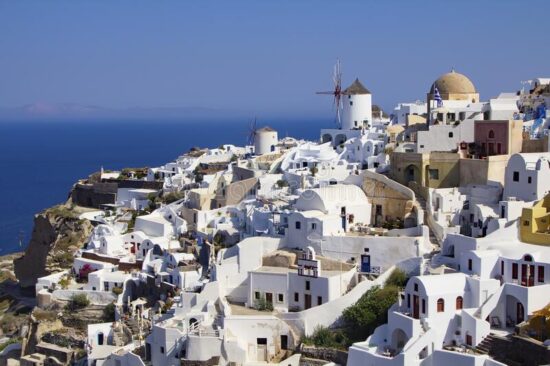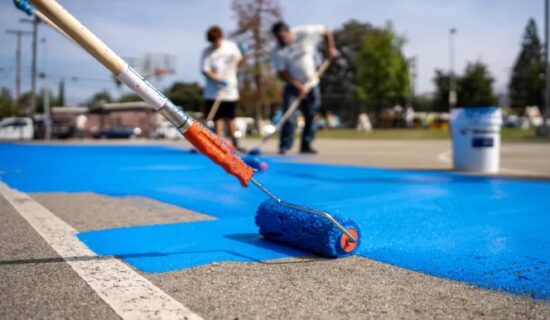I live in the middle of the city of Toronto. We are having another hot summer. Temperatures have reached the low 30s Celsius (mid-80s Fahrenheit) on some days with heat and humidex indices upwards of the high 30s or low 40s (feeling like 100 Fahrenheit or more). But when we visited a friend in the country a couple of weeks ago while Toronto was baking in the heat, conditions there were far more tolerable. Why is this?
Cities produce their own climate. The accumulation of buildings, the number of vehicles emitting greenhouse gasses, and the heat absorbing asphalt and cement surfaces on streets, playgrounds and parking lots, create a heat island effect making the city several degrees warmer than its surrounding countryside. Add aerosol pollutants to the mix and it gets even hotter. A simple solution exists, however, to reduce this urban heat island effect. It involves painting roofs, roads, sidewalks, playgrounds, and parking lots with reflective coatings that can deflect up to 80% of the heat-generating properties of sunlight.
In a 2019 interview done by the BBC, the former UN Secretary-General, Ban Ki-moon described creating cool roofs by applying white lime and a special reflective coating. The article referred to a project in Gujarat, India, and noted that this type of solution could help lower roof temperatures by as much as 30 Celsius, which in turn would reduce interior building temperatures by between 3 and 7 Celsius. Homes and buildings in India are particularly vulnerable to the urban heat island effect because the roofing materials used there are metal, asbestos or concrete and are heat-trapping even if coated in white.

It should be noted that coating buildings in white to reflect sunlight isn’t foreign to warmer climates. Mediterranean towns and cities have used white lime coatings and paint (see above) for centuries.
A recent project in New York City painted 930,000 square metres (10 million square feet) of rooftops white to lower surface and building interior temperatures
And California has updated its building codes to promote cool (that is white) and green roofs (roof plantings) which the state claims could yield up to 40% savings on air-conditioning.
The Berkeley Lab in San Francisco estimates the worldwide adoption of reflective rooftop coatings could have a global cooling effect equal to removing 24 Gigatons of carbon dioxide (CO2) emissions or eliminating 300 million cars from the world’s roads for two decades.
Project Drawdown, a global program that promotes green and white roofs has calculated that if the roofs of the world were painted at a rate of 8 to 10% annually, and green roofs were installed at a 9 to 11% annual rate, by 2050 it would reduce carbon emissions by 1.1 billion tons with energy cost savings amounting to close to a half trillion US dollars.
But forget 80% solar reflectivity with white paint. Recently, Purdue University researchers created a whiter paint that reflects 98.1% of sunlight by adding barium sulphate nanoparticles derived from the mineral barite. When embedded in the paint it creates reflective properties that if applied to only 1% of the planet’s surface could dramatically reduce global warming.
And now there is a blue paint special. It is the latest city-cooling paint project out of Los Angeles, California. A neighbourhood is covering more than 90,000 square metres of roads, playgrounds and parking lots with blue paint that reflects both visible and infrared light which also contributes to the urban heat island effect. The picture at the top of this posting has a team of workers painting a playground blue. Adding the ability to reflect infrared should produce a multiplier effect stated one of the Los Angeles paint project managers. And so far the results are promising. In early mid-day temperature tests, the painted areas of pavement are 18 Celsius (30 Fahrenheit) cooler than untreated surfaces.

















I’ve always been a fan of simple solutions. It’s astounding that green/painted roofs haven’t been part of the building code in any hot climate for generations. This is a case where architects and builders took the easiest or traditional option. I don’t even think cost is much of a factor here, as green/painted roofs are shown to be lower cost that tarred roofs.
Hi Steve, I agree with you that the simplicity of the solution as an adaptation strategy would deem it a no-brainer for cities to implement. Let your city councillor know. I am certainly sending mine this posting. Thanks for continuing to be a follower of my blog. I enjoy receiving your comments.
[…] a phenomenon one can observe on a cloudy day. Cities today are experimenting with white roofs and painting street and parking lot surfaces with highly reflective white or light blue […]